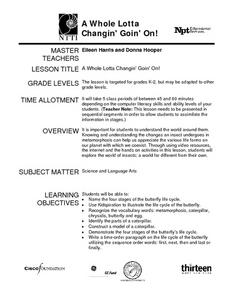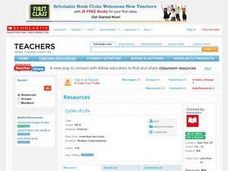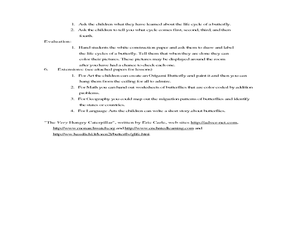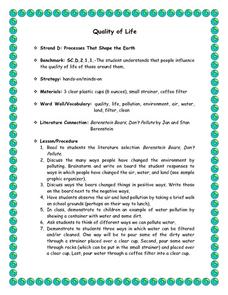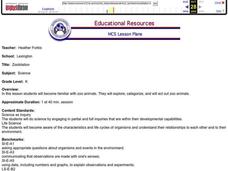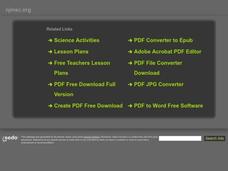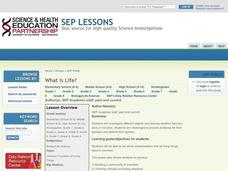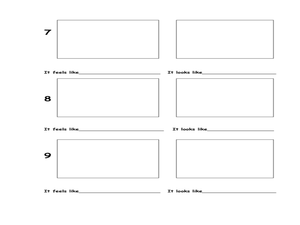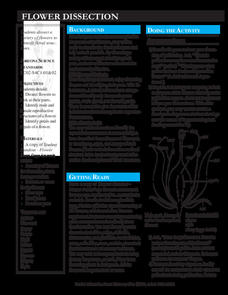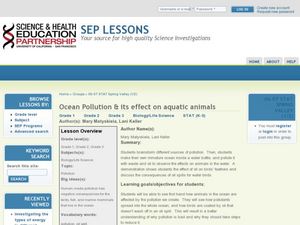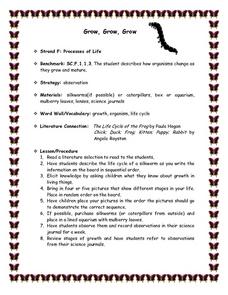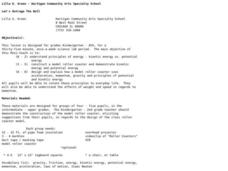NASA
The Science of the Sun
There's more to that glowing ball of light in sky than most children realize. From the overall structure of the solar system, to the changing of the seasons, these hands-on lessons open the eyes of young scientists to...
Cornell Lab of Ornithology
Life In A Nest: Exploring Life Cycles With Bird Cams
Why read about it when you can watch it happen? Bird cams make it possible for learners to experience the life cycle of a bird in real time! An engaging set of lessons provides activities to connect their learning to bird cam...
Curated OER
Urban Life: What Lives In Our Local Park?
Fifth graders participate in activities during a visit to Central Park. In this urban life lesson, 5th graders visit Central Park where they explore pond dipping, stream chemistry, and play a native plant Bingo game.
Curated OER
A Whole Lotta Changin' Goin' On
Here's a fabulous lesson on the life cycle of a butterfly. Youngsters are able to identify and understand the four stages of life. They construct models of a caterpillar and write a sequence story about the life of a butterfly. This...
Curated OER
Cycles of Life
Students explore the metamorphosis of an insect as it changes from an egg to pupa to an adult. the process of change is observed, recorded, and transformed into a life cycle picture.
Curated OER
Apples: Family and Consumer Science
Learning to cook and making good food choices are extremely important life skills. Seventh graders explore food science in relation to health and nutrition, by conducting several experiments on apples. Websites, movies, and instructional...
Curated OER
Sorting Things Out
Written to examine seeds that grow in Kansas, you can adapt this lesson plan to anywhere you live. Learners sort a mixture of five different seeds to by any characteristic of their choice. When your budding scientists are exploring the...
Curated OER
The Lifecycle of a Butterfly
Students study the life cycle of the butterfly. In this butterfly life cycle lesson, students examine and discuss a large diagram of the four stages of the butterfly life cycle. They read books and access web sites that extend their...
Curated OER
Quality of Life
Students discover that people influence the quality of life of those around them. They read the literature selection 'Berenstein Bears, Don't Pollute' and discuss the many ways people have changed the environment by polluting.
Curated OER
Beach Life: Clam Dissection
Students investigate clams. In this clam life lesson plan, students conduct an experiment where they dissect clams. Students compare anatomies of humans and clams.
Curated OER
Zoobilation
Youngsters become familiar with zoo animals. They sort them into categories, and choose an animal to act out. Two zoo centers are created in the classroom that have examples of the animals for the pupils to play with. Then, they choose...
Curated OER
Classification and Identification
Students, after exploring and analyzing diagrammatic and taxonomic keys and their association to marine sciences, identify and classify objects and organisms based on visual attributes/characteristics. They research and create their own...
Curated OER
Global Warming
First graders discover the effects of global warming on polar bears. For this life science lesson, 1st graders model the polar bear's habitat and observe what happens as they raise the temperature. They record their observation in the...
Curated OER
Effects of Oil Spills on Environment and Marine Life
Students explore oceanography by conducting an environmental experiment in class. In this oil spill lesson, students discuss the human need for oil and what is at stake when we drill for oil in our oceans. Students read a book in class...
Society of Petroleum Engineers
Renewable and Nonrenewable Energy
Energize an environmental science unit on natural resources with this collection of instructional materials. From simple coloring sheets for primary grade children, to guiding questions for a high school research...
Curated OER
What is Life?
Students investigate the characteristics of living things. In this life science lesson, students examine several living and non-living specimens. Students determine which things are living and non-living.
Curated OER
The Spider's Life Cycle
Young scholars see that spiders have a life cycle, and reproduce by laying many eggs. We can count by ones, twos, fives, or as many as we want. They make two lists of animals on a chart.
Curated OER
Life Cycle of the Butterfly
Students observe and analyze the life cycle and metamorphosis of the Painted Lady Butterfly. They write observation journal entries three times a week and summarize what they observed. Using KidPix computer software they create pictures...
Curated OER
Exploring Marine Objects
Students identify the sources of water on Earth. In this life science lesson, students list the different plants and animals that live in the ocean. They explore marine objects in the lab and draw them.
Curated OER
Flower Dissection
Beginning biologists pull a flower apart and familiarize themselves with the different reproductive structures. Why have them learn only from just a book or diagram when they can examine real samples? There is no link to the referenced...
Curated OER
Ocean Pollution & its Effect on Aquatic Animals
Students consider the concept of ocean pollution. In this ocean instructional activity, students participate in a hands-on demonstration in order to replicate an oil spill and its effects on marine life.
Curated OER
Grow, Grow, Grow
Young scholars listen to literature selection, describe life cycle of silkworm, discuss what they know about growth in living things, observe silkworms for one week and record observations in science journals, and review stages of growth.
Curated OER
PLANT LIFE CYCLES
Student learns about the life cycle of plants by watching a time-lapse video. This activity provides students with further evidence that all living things grow and change as they progress through their life cycle. Student conducts a...
Curated OER
Let's Outrage the Bull
Learners study kinetic and potential energy. In this energy lesson, students in grades K-2 understand the differences between kinetic and potential energy. Learners in grades 3-5 demonstrate that kinetic and potential energy. Students in...
Other popular searches
- K 2 Life Science Growth
- K 2 Life Science Living
- K 2 Life Science Insects
- K 2 Life Science Salamander
- K 2 Life Science Hibernation
- K 2 Life Science Adaptation
- K 2 Life Science Cells
- K 2 Life Science Nonliving
- K 2 Life Science Wind



